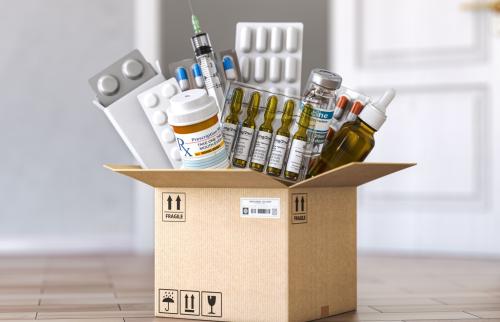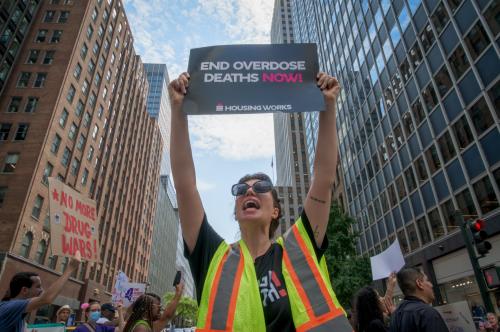Introduction
A key feature of the Inflation Reduction Act (IRA) is the establishment of a prescription drug negotiation process between manufacturers and the Secretary of the U.S. Department of Health and Human Services.1 Lawmakers characterized the IRA’s drug negotiation provisions as balancing the desire to make brand-name drugs more affordable by lowering prices while recognizing the need to retain incentives for pharmaceutical innovation.2 One way lawmakers aimed to achieve this goal was by allowing a period of market exclusivity for drug manufacturers before price negotiations, thereby giving them time to earn a return on their investment in research and development (R&D).
Manufacturers have expressed two concerns about the period of exclusivity allowed before negotiation. First, manufacturers argue that negotiation happens too early in the product lifecycle, thereby diminishing revenue generation in Medicare and reducing the incentive to invest in such products. Second, they object to provisions creating a shorter exclusivity period for small molecule products compared to biological products, set in the IRA as 9 and 13 years, respectively. Manufacturers argue this differential will result in reduced product pipelines for new small molecule drugs in favor of biological products.3
In this paper, we investigate publicly available data on the net sales of drugs selected for the second round of negotiation and a set of drugs likely to be selected in upcoming rounds. We compare these findings to previously published research that estimates the revenue required to provide an adequate return on investment in R&D,4 with the goal of assessing whether the timing of negotiations might make R&D investment unprofitable. We also consider the factors that will drive the composition of drugs selected for negotiation in the future.
Background
Criteria for the selection of drugs for negotiation
Under the law, no small molecule drug will have negotiated prices applied until at least year 9 after approval; for biologics, the waiting period is 13 years. But the selection process for negotiation begins two years prior. That process follows eligibility criteria spelled out in the IRA. Selected drugs must be single source drugs and have annual Medicare sales of $200 million or more in the year prior to selection (the $200 million standard is indexed to inflation). The IRA excludes plasma-derived products, true orphan drugs designated for one rare condition, and, in the initial years, products manufactured by small biotech companies.
Among drugs that are eligible, the Centers for Medicare and Medicaid Services (CMS) then selects for negotiation the drugs with the highest Medicare gross spending in the year prior to selection.
Methodology and data used in the analysis
We estimate cumulative net sales for individual drugs already selected to have negotiated prices to take effect in 2027 and a set of drugs potentially eligible in upcoming cycles. We estimate net sales using publicly available data from Form 10-K and 10-Q filings to the Securities and Exchange Commission (SEC) that have been processed by SSR Health. Our measure captures all global sales and is net of rebates, 340B discounts, chargebacks, patient assistance programs, and other discounts. To account for the variation in entry years within each cohort, we inflate all sales to 2024 dollars by the Consumer Price Index for All Urban Consumers (CPI-U).
We construct our set of drugs potentially eligible in upcoming cycles by identifying drugs approved between 2017 and 2019, which may be eligible for negotiation during the 2026-to-2032 time window. We eliminate any drugs that are currently eligible for the small biotech exemption (which expires in 2028) or which have a single orphan indication (even though some of those may become negotiation eligible), as well as drugs that have less than $200 million in Part B and D Medicare sales in 2022 as reported on the CMS prescription drug dashboard. The remaining [19] drugs are the cohort of interest.
Our focus is on comparing whether retained net total revenues (or sales) for each product with estimates of the future retained sales a firm would need to expect before beginning a drug development program. To make this comparison, we use the reported net sales in 10-K and 10-Q filings, the costs of production for drugs, and the average cost of bringing a drug to market as a marker of achieving a competitive return on investment. Two recent literature reviews have closely examined the wide range of estimates of the costs of bringing new drugs to market.5 The two reviews noted the large range of estimates that have been produced in the literature and the great within-study heterogeneity in the estimated cost of development for specific drugs. The Congressional Budget Office (CBO) identified the range as being from roughly $1.2 billion to $2.3 billion in 2019 dollars. Schlander and colleagues identified an even larger range ($0.9 billion to $4.5 billion in 2019 dollars). Both reviews noted the importance of outliers and differences in the transparency of methods and data.
The Schlander study did extensive analysis to arrive at a quality rating for the studies in the literature. In this analysis, we use the estimate that is rated highest in the Schlander study, which was also highlighted in the CBO review, by Wouters and colleagues.6 They reported a $1.3 billion cost in 2019 dollars that inflated to 2024 dollars is $1.57 billion, which we round up to $1.6 billion.7 To account for the possibility that development costs may vary across drugs, we also consider a higher $2.8 billion threshold, which corresponds to the top end of the CBO range cited above, updated to 2024 dollars.
We will next consider adjusting the total net sales estimates to account for production cost. The costs of producing small molecule drugs are negligible8 (a penny a pill).9 For biologic drugs, the production process is more complicated. There is little systematic analysis of those costs. One study examined the production costs offered and estimated that implied production costs were roughly 5% of revenues for branded biologic products.10 Thus, we reduce our net sales estimate by 5% to obtain a measure of retained net sales.
A final caveat with our approach is that, while the estimate of the cost of a new drug that we use here does take into account pre-clinical development costs, some of those costs may be joint across products in related biological and therapeutic areas. For this reason, reducing the net sales of the drugs subject to negotiation could, in principle, reduce the incentive to invest in drugs that are not subject to negotiation, which our approach would not capture. However, because pre-clinical costs are only a fraction of overall development costs, the joint cost effect seems likely to be quite small.11
Results
Figure 1 shows the cumulative net retained sales through the 8th year post-FDA approval for drugs selected for negotiation of prices that will take effect in 2027.12 Figures 2 and 3 show cumulative sales to date for a likely set of negotiation-eligible drugs approved between 2017 and 2019.
At the high end, Ozempic and its related formulations achieved cumulative earnings of $43.1 billion in just under 7 years. At the lower end of earnings for the drugs that will have negotiated prices take effect in 2027 is Tradjenta, which realized cumulative net earnings of $3.3 billion in 8 years on the market.
Figure 1 indicates that by year 8, all the drugs selected for negotiation had net earnings higher than $1.6 billion, with median and mean time-to-$1.6 billion of 3.88 and 3.86 years, respectively.
Figures 2 and 3 display the cumulative net retained sales for 19 drugs likely to be selected in the subsequent negotiation cohorts, for small molecule and biologic products, respectively. We present the biologics and small molecules separately for ease of visibility and because their time to negotiation eligibility differs. Since most of the drugs have not been on the market for 8 years in 2024, we project the 8-year cumulative earnings by taking the last year of actual earnings and assuming that sales would remain at that level through year 8 (indicated by hashed extensions of the trend lines in the figures). Biktarvy was the top drug with respect to cumulative earnings at $46.12 billion within 7 years. Juluca was the drug with the lowest cumulative net earnings among small molecule products for just under 8 years at $3.56 billion. Note that for the cohorts described in Figures 2 and 3, all 19 small molecule products have cumulative net sales above $1.6 billion by year 6 of their time on the market. Libtayo, shown on Figure 3, had the lowest cumulative sales among biological products at $2.1 billion after 6.5 years on the market. The 8-year projected cumulative earnings were $3.1 billion. Since Libtayo is a biological product, it will not be facing negotiated prices for another 6.5 years. Note that between 2022 and 2023, Libtayo’s real net sales grew by 38%. Median and mean time-to-1.6 billion was 3.25 and 3.25 years for small molecules in this sample versus 3.25 and 3.19 years for biologics. Thus, even if we chose the estimate of $2.8 billion ($2.3 billion in 2019 dollars adjusted for CPI-U increases to 2024) that CBO reported as anchoring the high end of their view of the range of estimates all drugs would have arrived at net retained sales of above that figure when they became subject to negotiated prices.
Looking ahead
Thus far, we have considered products that have been selected or are likely to be selected in the near term. We have shown that the most proximate cohorts of drugs have all achieved retained net sales of more than the $1.6 billion level necessary to adequately compensate firms for their investments in R&D. Indeed, these products all appear to be on track to greatly exceed that level by the time they become negotiation eligible.
It is important to consider how the experience of future cohorts of drugs might differ. There is considerable uncertainty about the exact profile of drugs that will populate future cohorts of drugs eligible for negotiation. However, there is reason to suspect that future cohorts of negotiation-eligible drugs will actually be at least as likely to surpass this net sales threshold as prior cohorts of negotiation-eligible drugs.
Notably, the share of total pharmaceutical sales accounted for by sales outside the U.S. has been growing in recent years,13 and global prescription drug spending is expected to continue growing faster than U.S. sales.14 This suggests that any given level of Medicare sales is likely to correspond to a higher level of global net sales in the future than it has in the past. In particular, it suggests that limiting negotiation to drugs with gross Medicare sales in excess of the IRA’s threshold level ($200 million initially, indexed forward based on the Consumer Price Index in later years) will tend to select drugs with higher total net sales in future years than in the past. Since the drugs that have been selected or are likely to be selected in the near term have all met the $1.6 billion net sales threshold considered in this analysis, this seems likely to remain true in the future.
As a check on this point, we examined a group of products approved in 2020 and 2021 with over $200 million in Medicare sales, that would be eligible to carry negotiated prices beginning in 2029 for small molecules and 2033 for biologicals. That includes Nurtec, Epclusa, Biktarvy, and Tepezza. Even for drugs that had only been on the market for 4 years, all had cumulative retained net sales of over $1.6 billion.
In sum, it appears unlikely that drugs with less than $1.6 billion in global retained net sales will be considered for negotiation well into the 2030s and potentially well beyond that.
Appendix
-
Acknowledgements and disclosures
The authors thank Marta Wosińska, Matthew Fiedler, and Christen Linke Young for helpful contributions on earlier drafts. The authors also thank Ben Graham for excellent research assistance and Rasa Siniakovas for editorial assistance.
The authors gratefully acknowledge financial support from Arnold Ventures.
-
Footnotes
- Congressional Research Service, Medicare Drug Price Negotiation Under the Inflation Reduction Act: Responses and Potential Effects, R47872, December 8, 2023.
- Congressional Research Service, Medicare Drug Price Negotiation Under the Inflation Reduction Act: Responses and Potential Effects, R47872.5, December 2023.
- Frank RG et al., Amicus Brief on the Inflation Reduction Act’s drug pricing provisions, The Brookings Institution, April 30, 2025.
- Frank RG, C Rowley, Medicare Negotiations Won’t Keep Pharma from Making a Fortune, Bloomberg, September 5, 2023.
- Congressional Budget Office, Research and Development in the Pharmaceutical Industry, April 2021; and Schlander et al., How Much Does It Cost to Research and Develop a New Drug? A Systematic Review and Assessment, PharmacoEconomics, August 9, 2021.
- Wouters OJ, McKee M, Luyten J, Estimated research and development investment needed to bring a new medicine to market, 2009–2018. JAMA. 2020;323(9):844–53.
- We apply the CPI-U to convert 2019 to 2024 dollars, which implies a factor of 1.21.
- An analysis by the Boston Consulting Group demonstrated that the production cost for a pack of small molecule drugs can range from $2.50 to 7.50. They note that production costs decrease as firm size and production runs increase. Because our sample is large firms and drugs with large sales volume, we expect the COGS is closer to the lower end of the range and therefore negligible. Likewise, with biologics, BCG finds an average production cost of $60 per pack. Given the high prices for the drugs discussed, we arrive at an estimate of 5%. See, Gooch, J. et al., What Does—and Does Not—Drive Biopharma Cost Performance, The Boston Consulting Group, July 7, 2017.
- Favour, D, Biologics vs small molecules: Drug costs and patient access, Medicine in Drug Discovery 9, 2021.
- Ibid.
- Op cite notes v and vi.
- Centers for Medicare and Medicaid Services, “HHS announces 15 additional drugs selected for Medicare drug price negotiations in continued effort to lower prescription drug costs for seniors.” January 17, 2025. https://www.cms.gov/newsroom/press-releases/hhs-announces-15-additional-drugs-selected-medicare-drug-price-negotiations-continued-effort-lower.
- IQVIA, The Global Use of Medicines 2024: Outlook to 2028, January 16, 2024. https://www.iqvia.com/insights/the-iqvia-institute/reports-and-publications/reports/the-global-use-of-medicines-2024-outlook-to-2028.
- Op cite note xii.
The Brookings Institution is committed to quality, independence, and impact.
We are supported by a diverse array of funders. In line with our values and policies, each Brookings publication represents the sole views of its author(s).








